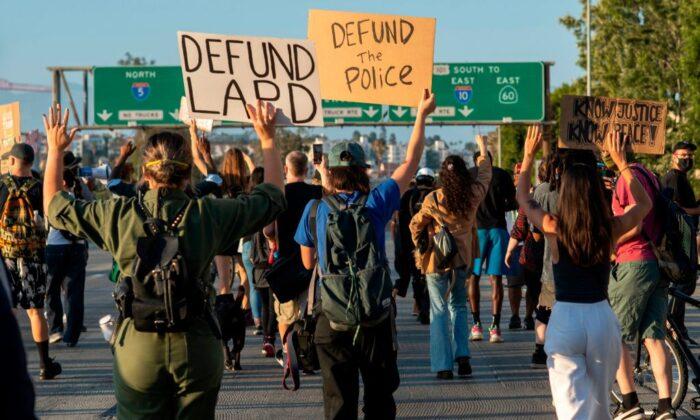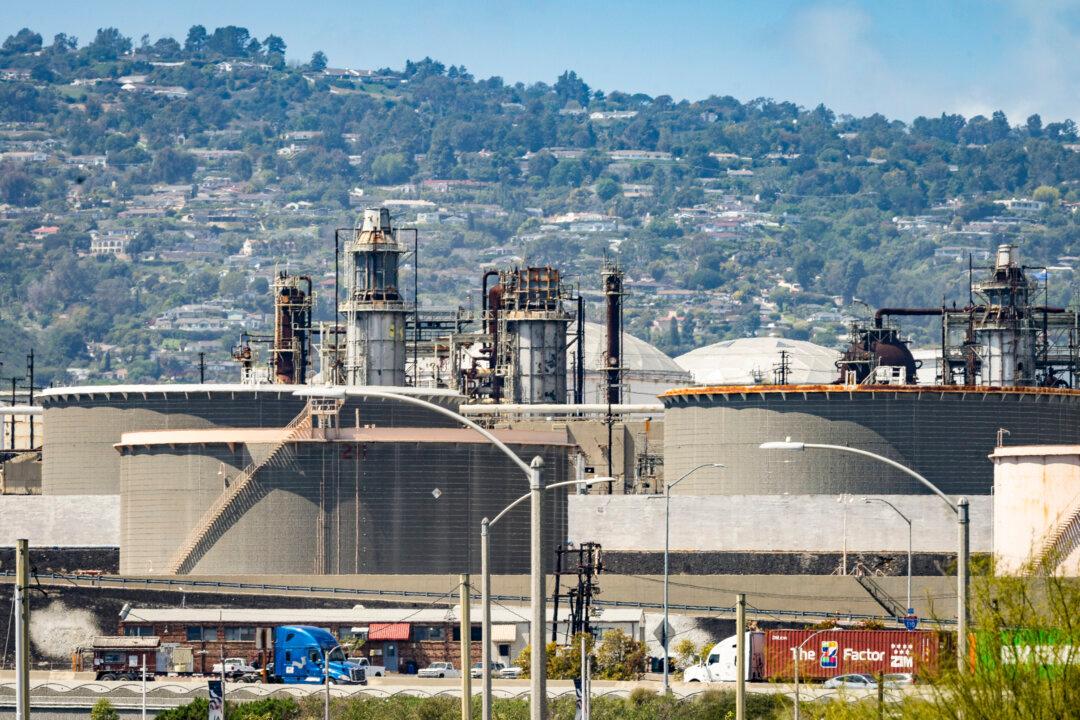Activists and celebrities who tell people that police are hunting “black and brown targets” are hurting minority communities more than helping, says one of California’s top cops.
“It’s just reprehensible to me. Nothing could be further from the truth,” Eric Nuñez, the president of the California Police Chiefs Association (CPCA) and chief of police of Los Alamitos in Orange County, told The Epoch Times.
He listed the challenges that police have faced recently: disdain from activists, Black Lives Matter (BLM) calls to defund police, a spate of new reform bills in California, widespread protests, riots, and many pandemic-related challenges. Police also have been contending with several problems that include declining recruitment, alarming rates of suicide, plummeting morale, and rising attrition, he said.
While Nuñez understands the pain that people have suffered this year because of the pandemic and following the death of George Floyd, he said too much anger has been unfairly directed at all officers.
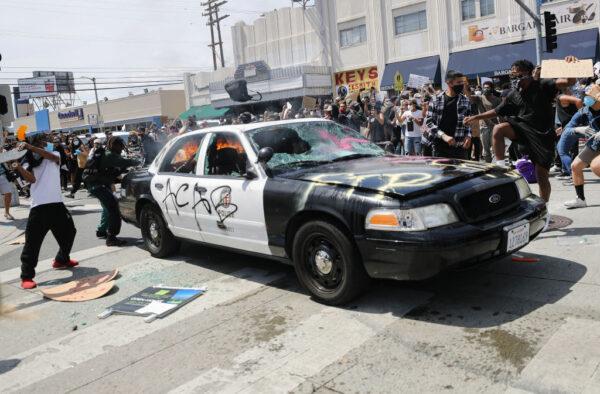
A Los Angeles Police Department vehicle is set on fire by protesters during demonstrations in Los Angeles, on May 30, 2020, following the death of George Floyd. Mario Tama/Getty Images
It’s disheartening, he said, for police officers to hear disparaging remarks about them from sports celebrities such as NBA superstar LeBron James and former NFL quarterback Colin Kaepernick, among others.
“To hear celebrities come out and talk so poorly about law enforcement is discouraging because a lot of these law enforcement officers are athletes, or were athletes,” Nuñez said. “They have celebrities they like, and athletic heroes they admire.”
Despite their uniforms, police are people first, he said.
“Granted, they are trained more than the average person, but they’re human beings.
“They’re not superheroes. … They’re not manufactured from some sort of factory. These are people that grew up in the same neighborhoods that you and I grew up in, and they’re a microcosm of the world itself.”
Police Sympathize With Protesters
When police officers watched the video of Floyd’s arrest in Minneapolis, they were as shocked as anyone else, Nuñez said. “That was beyond comprehension for most police officers. … They looked at it as being cruel. You know, they saw it for what it was worth, but that’s not them.”During the protests that followed, police respected the constitutional right to demonstrate peacefully, he said. In some cities, “you saw a lot of cops ... that were taking a knee … because they wanted to express this kind of idea that we understand. We’re here. We’re with you, and if this is what it takes to convince you, then this is what we’ll do.
“Overall, people who join this profession do this because they want to help,” he said. “They want to help people that are being victimized by people who want to commit crimes against them. They don’t do this because they’re looking to get into a shooting.”
Just as the majority of peaceful protesters don’t want to be lumped in with rioters, vandals, and looters, Nuñez said, neither do police want to be blamed for the brutality of some bad officers.
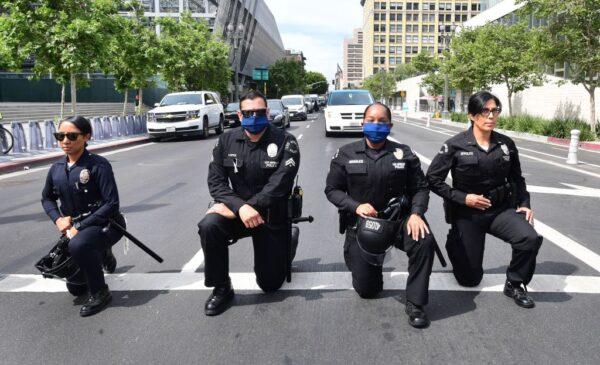
Los Angeles Police Department officers kneel during a rally led by Baptist Ministers to City Hall in memory of George Floyd on June 2, 2020. Frederic J. Brown/AFP via Getty Images
“If you look at California DOJ’s [Department of Justice] record of use of force that results in serious injury and/or death, for the last three years, those incidents have gone down—small amounts, but they’ve gone down,” he said.
Most officers are just doing their jobs, risking their own lives to protect others from injustice and harm and they believe policing is a noble profession, he said.
“And when I say ‘most,’ I mean [more than] 99 percent.”
But, he said, activist groups and the news media don’t want to hear about it.
“I guess they don’t look at that. … You can’t even talk about it in most of the groups that you have to deal with because there’s so much hurt. And I understand that hurt. I understand the anger. But some of it is misplaced—some of it has been for things that happened way before many of these guys were even cops.”
‘Heartbreaking’ to See Kids Worried About Cops
Nuñez blames the news media for spreading disinformation rather than allaying unwarranted fears “about police officers specifically going out and using unnecessary force and deadly force on minorities.”He said most journalists know that the majority of police officers aren’t targeting anyone except suspected criminals. If they don’t know, honest research would show them that, he said.
“The media knows this, or at least they could find this out, and they could help with calming people down instead of creating and fanning those flames of uncertainty.”
He said journalists could help send the message that “police officers are not actually hunting black and brown targets,” and reassure people, especially minorities, “You’re safer than that—a lot safer.”
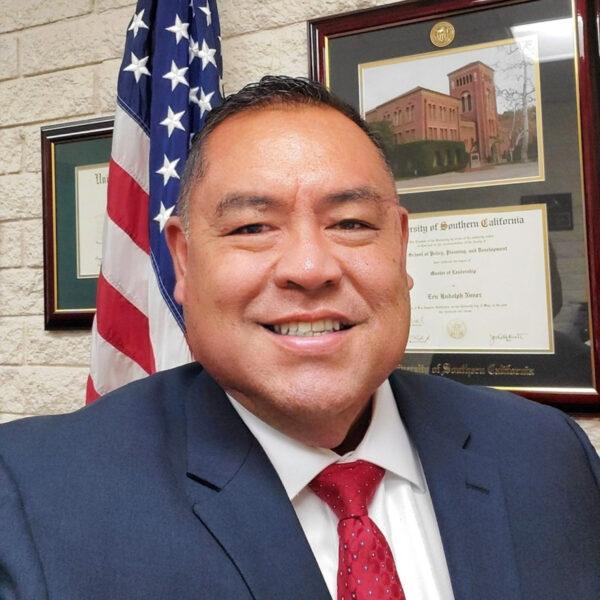
Eric Nuñez, the president of the California Police Chiefs Association (CPCA) and chief of police of Los Alamitos in Orange County, Calif. Courtesy of Eric Nuñez
“I saw these kids worried about cops going out there and hurting their fathers or big brothers, their mothers, and themselves—it was just so heartbreaking,” he said.
“We’re the same police officers that were around after 9-11. We’re the same cops that were working here when COVID first hit and we were all going out celebrating people’s birthday parties and stuff like that—driving police cars and hitting our sirens, showing support for our community and for our first responders in the hospital settings.
“And then all of a sudden, we became the villain almost overnight.”
He says many people dismiss violence in Ultimate Fighting Championship (UFC) matches, boxing, and even football as “Well, it’s sports.”
Yet, when police officers have to use force in the line of duty, to protect themselves or others, it’s often frowned upon by activists.
“I always tell people that the use of force is never pretty,” he said. “Law enforcement isn’t sport. It’s reality. There’s a certain finality that comes with what we do, or potential of that finality.”
Police are trained to take control of violent situations and may be required to use physical force or deadly force to protect the lives of potential victims, and their own lives. But that context is lost on social media and even the news media, which often portray police as bullies for doing their jobs, he said.
In some cities, officers have had to police social justice protests night after night for months.
“It’s been chaotic. It’s been stressful. That is wearing on the nerves of the officers that have to go there every day, every night and have to face that kind of level of vitriol for things and acts that they didn’t actually commit themselves,” he said.
“When you consider the amount of vitriol and animosity and even physical assaults police are facing … [since] those original protests and riots and, and [from] Antifa groups, imagine having to be a police officer … on hyper-alert for these things for a sustained period of time. It has to wear on you.”
The media spotlight on activist groups is amplifying the “amount of disdain that this vocal group of people,” has against the police, “so much so that [officers] … just feel like they’re being attacked.”
Lockdowns Contribute to Unrest
Nuñez said he believes the COVID-19 lockdowns are partly to blame for civil unrest, since people are cooped up, restless, stressed, and wanting to get together with others. He acknowledges the seriousness of the illness as driving the lockdowns, while not minimizing the genuine concerns motivating protesters as well.“I think some of that [unrest] is a result of being locked in for months with COVID-19 and having all this angst. Everybody is going through this and wanting to be able to get out, I guess, or come together,” he said. “We’re social human beings. We thrive—not everybody, but obviously, the majority of people—on interacting with society, and being deprived of that causes us some issues.”
Nuñez’s wife works at a hospital and her accounts of patients dying or clinging to life on ventilators have brought the reality of the pandemic home to him. But he’s worried that overreacting to the health crisis could also hurt the nation.
“I know that COVID-19 is a reality, and I also know that it’s killing a significant amount of Americans, but I always felt like our reaction to COVID-19 could possibly—and I don’t want to be melodramatic—cause some serious injury or death to America itself.”
Legislation, Criminal Justice Reforms
Early in the year, CPCA was concerned about a few bills proposed by state legislators related to policing, and the organization was prepared to fight the legislation. But when protests erupted in late May, state lawmakers reacted by introducing more than two dozen new bills related to policing.“The legislators came back from their break, and within a short time, we had about 25 bills of serious concern. Of those 25 bills, I believe 23 of them were gut-and-amend bills,” which are difficult to track and review because they usually change so much throughout the legislative process between the State Assembly and Senate, he said.
Police had less than two months to review the bills before the end of the legislative session on July 31, and the frantic pace became “extremely reckless,” Nuñez said.
“There wasn’t enough time to actually sit down and talk about these things.”
For example, Senate Bill 776 would have opened all complaints of officer violence to the California Public Records Act and left them there permanently. CPCA felt the bill was crafted too quickly and could have unintended consequences. It could cost millions of dollars in additional record-keeping, and even unsubstantiated complaints against officers would be open to the public.
The legislation ran out of time in the Senate and wasn’t approved.
Assembly Bill 66 would have greatly restricted the use of tear gas and rubber bullets for crowd control. AB 66 also ran out of time and came up short of approval.
While CPCA agreed in theory with some of the proposals, the group said the details and implications of them were too many to carefully consider in a short timeline.
On the other hand, Nuñez said, law enforcement worked with lawmakers for more than a year on reform legislation that CPCA supported, Senate Bill 230. It will bring reforms to police training related to the use of deadly force. Newsom signed it into law on Sept. 12.
Proposition 20
Proposition 20 was a ballot measure last month that CPCA strongly supported. The group described Prop. 20 as seeking to undo legislation put in place in recent years that has “led to increased shoplifting, limited DNA evidence collection, and the early release of dangerous individuals.”Nuñez said the collection of DNA samples for criminals arrested for petty theft and drug offenses is important because it often leads to the arrests of repeat offenders for more serious crimes in the future.
Voters rejected the legislation.
Two pieces of legislation Prop. 20 would have undone are Proposition 57 and Proposition 47.
Prop. 57 made it easier for people convicted of nonviolent crimes to get parole. The problem is, according to CPCA, that many “nonviolent” criminals are still dangerous. In California, some crimes considered nonviolent are domestic abuse, solicitation to commit murder, rape of an unconscious person, and child trafficking.
Prop. 47 reduced some felonies to misdemeanors. According to CPCA, reducing felonies to misdemeanors, particularly for theft, has led to the proliferation of organized shoplifting rings.
On the other hand, supporters of these two propositions have said they would result in fewer inmates, shorter sentences, and overall reduced prison costs, with any savings to be used instead for rehabilitation programs, as well as schools.
Nuñez said he wasn’t impressed with the decision of then-Attorney General Kamala Harris to name Prop. 47 the “Safe Neighborhoods and Safe Schools Act.” He said that’s “a horrible title for it.”
In California, the attorney general is responsible for writing ballot titles and summaries used to inform voters about the measures. The issue of alleged bias in the wording, swaying voters one way or another, has been much-discussed for years. Some lawsuits were filed against Attorney General Xavier Becerra this year over the wording of various measures.
Proponents of Prop. 20 also criticized its wording as biased. The summary emphasized restrictions on parole for non-violent offenders and the increase in correctional costs “likely in the tens of millions of dollars annually.”
Nuñez said, “Our concerns over legislation over the last 10 years have increased, it feels like tenfold.”
He’s worried that California’s softening of penalties might eventually lead the state to follow Oregon’s lead: Voters there passed a measure that makes possession of certain amounts of heroin, cocaine, and methamphetamine no longer punishable by incarceration. Selling and manufacturing the drugs still carry heavier penalties.
As a kid growing up in “kind of a rough neighborhood in southeast L.A. … where there was a lot of drugs and gangs, a lot of us saw how even alcohol ... just really tore apart families and made people—even our contemporaries or our peers—make bad decisions and wind up getting killed in accidents and doing bad stuff,” Nuñez said.
Police Morale and Suicides
Nuñez, 58, has been a police chief for a decade—five years in Los Alamitos and five years in La Palma before that. In May, he will have been an officer for 30 years.He was elected the 55th president of the California Police Chiefs Association (CPCA) in March, and was sworn in somewhat unceremoniously during a Zoom meeting, without all the usual pomp and circumstance of a three-and-a-half-day conference.
Right from the start of the pandemic, he knew 2020 “was going to be a lot different” than other years.
One of his first priorities was to set up a Committee for Officer Wellness and Resiliency.
“About 140 cops are killed every year, by their own gun,” Nuñez said. “Officer suicide is a problem.”
Police officers are more likely to die by suicide than in the line of duty, according to research from the Ruderman Family Foundation. In 2017, at least 140 police officers took their own lives compared to 129 officers who died in the line of duty.
One survey of small and midsize police departments cited in the study found that, on average, police officers witness 188 “critical incidents” during their careers, and the constant trauma can lead to mental illness.
Post-Traumatic Stress Syndrome (PTSD) and depression rates are as much as five times higher among police officers than the civilian population.
Many officers suffer in silence with untreated mental illness, which can lead to poor physical health and impaired decision-making, the research found.
“You see the worst stuff imaginable, frequently, and that’s not normal for people,” Nuñez said.
“If I went around and asked my neighbors, ‘Have you ever seen anybody shoot themselves in the head, or anybody ever get shot or set on fire?’… most people in my neighborhood would say ‘no.’ … But, you know, cops see it, and they see it on a semi-regular basis.”
Nuñez has noticed a trend of more experienced officers taking early retirement while police departments are struggling to recruit new officers, he said.
“I’ve seen a number of chiefs retiring sooner and just police personnel in general. I think these times have been straining on our folks. I know it’s been difficult just to recruit people in normal circumstances.”
A September 2019 Police Executive Research Forum report outlined a “workforce crisis,” with many law enforcement agencies unable to recruit new officers or keep the ones they have. A retirement bubble is looming, it said, “with a growing number of officers who entered policing during the federally funded hiring programs of the 1990s ... now reaching retirement age.”
Officers told The Epoch Times in April that they took early retirement because of increasing dissatisfaction, especially because of public anger toward the profession. Nuñez said he’s noticed more retirements since May.
Though his term at the helm of “Cal Chiefs” is still months from over, Nuñez is hopeful police will continue to stay the course and weather what has really been a perfect storm.
“It’s been a whirlwind,” he said.
